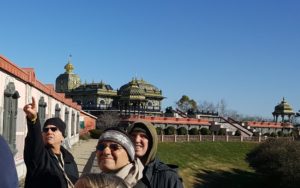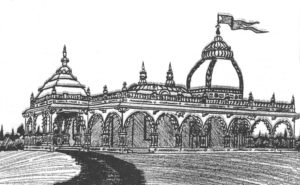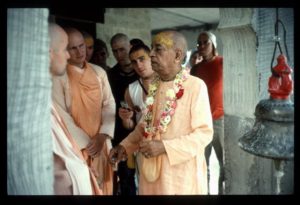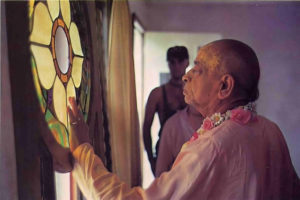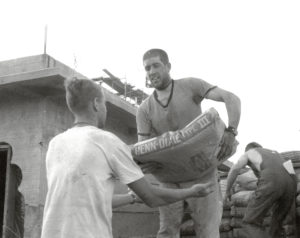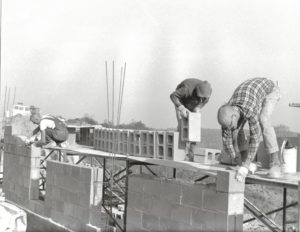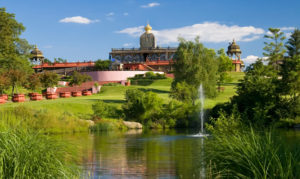Srila Prabhupada and His Palace
By Madhava Smullen for ISKCON New Vrindaban Communications
Archival Research by Chaitanya Mangala Das
It’s a crisp, frosty November day in the Appalachian foothills of West Virginia, bare trees silhouetted against a clear blue sky. On one hilltop, an unusually royal building stands out, sunlight glinting off its gold-filigreed domes and spires.
Participants of ISKCON New Vrindaban and ECO-Vrindaban’s winter 2016 Board Meetings, wrapped up warmly in coats and scarves, are being shown the latest renovations at Srila Prabhupada’s Palace by restoration manager Gopisa Das.
He points out the new drainage system, rose-colored steps, and weatherproof outer wall with ornate window arches, and describes plans to rebuild the Palace roof. “My concern in all of this is, ‘Am I pleasing Srila Prabhupada?’” he says. “And, am I taking care of his Palace?”
It’s the same loving service mood that devotees had when first planning to construct a home for Srila Prabhupada back in 1972, during a similarly frigid New Vrindaban winter. And if we take a trip back there, we’ll see how Prabhupada reciprocated that love, and how he had such a close connection with his Palace that it still inspires such devotion today.
As early as 1968, Srila Prabhupada was already saying that he wanted to be less involved in the day-to-day management of ISKCON, and focus more on what he saw as his top priority and longest lasting contribution – translating Vaishnava scriptures and writing his purports.
New Vrindaban’s peaceful rural atmosphere, he felt, would be the perfect setting. “If this piece of land is turned into New Vrindaban then I shall forget to return to Indian Vrindaban,” he wrote. “I am getting older and older, so actually if I get a peaceful place as described by you, the rest of my life will be continued in translating Srimad Bhagavatam and other Goswami literature…”
Srila Prabhupada first visited New Vrindaban in 1969, and again in September 1972, to give his epic Bhagavat Dharma discourses to hundreds of devotees, guests and reporters. During this second visit, he stayed in an old farmhouse on the Madhuban property with no running water, indoor toilet or shower facilities.
Prabhupada was happy to adopt the simple mood of New Vrindaban, comparing it to his old home in the original sacred Indian town. “This Vrindaban, that Vrindavan, no difference,” he said.
But New Vrindaban residents wanted their spiritual master to be more comfortable. Some of them decided they should build a nice home for him to live in during future visits, and especially if he did move to New Vrindaban long term.
Before that, however, they planned to construct a Govindaji temple, the first of Prabhupada’s seven proposed replicas of Vrindavan’s main mandirs.
But one winter’s day in 1972, as they were discussing design plans for the temple, they came across a passage in the Nectar of Devotion, in which Lord Shiva tells Parvati, “The worship of the Supreme Person is considered to be the highest. But even higher than the worship of the Lord is the worship of the Lord’s devotees.”
The message was clear. The Brijabasis decided to first construct a home for Srila Prabhupada. It would be a simple little retreat where he could retire to finish his books while his disciples took over the management of preaching work. It might, they estimated, take a year to build.
But by the time the groundbreaking ceremony was held at the area dubbed “Guruban,” during a June 1973 festival, the plans had become so elaborate and ambitious that Prabhupada’s home was being referred to as his “palace.”
Devotees’ excitement escalated over the grand weekend festival, which saw five fire yajnas conducted. Srila Prabhupada was just as thrilled. “I shall go to New Vrindaban as soon as your palace is finished,” he wrote that July. “Jaya!”
The team of devotees that set about building the Palace worked with no pay and very little experience, training themselves in construction and artisanal skills. And they labored through extraordinary challenges: working in the hot sun during the summers and in freezing conditions during the winters, they had to lay drains and mix concrete by hand because there was no electricity.
“There was no running water either,” recalls Soma Das. “We would scoop the water out of mud puddles to mix the cement with. And when those dried up, we’d load plastic barrels into a wheelbarrow, walk half a mile to the Madhuban farm, draw water from the well there, and wheel it all the way back to the construction site.”
Despite all these hardships, the devotees felt fortunate and grateful to be able to render service to Srila Prabhupada in New Vrindaban. And Prabhupada boosted everyone with his loving encouragement when he came to see his Palace for the first time in July 1974.
An entourage followed him as he took a tour of the construction site, tapping the walls with his cane to make sure they were solid, and beaming as he was shown where his bedroom, bathroom, temple room and study would be.
“Srila Prabhupada,” Bali Mardan Das commented, “It says in the Krishna book that the palaces of Dwarka didn’t even need any light, because they had so many jewels on the wall.”
Prabhupada stopped walking and guestured at the devotees working on his Palace. “These devotees,” he said, “Are my jewels.”
When Kirtanananda Swami told Prabhupada the Palace would be ready soon and asked him to be patient with them, Prabhupada said, “I already am.” He added, “If you want, I am already living here.”
As he left, he personally thanked the workers, lifting their hearts.
Srila Prabhupada continued to exhibit a lot of enthusiasm for the project and for moving to New Vrindaban. In letters later in 1974, he wrote that he had “enjoyed the atmosphere of New Vrindaban” during his visit, and that “When my palace will be ready I shall go there and stay. I like very much that place, very calm and quiet.”
In September 1974, Kuladri Das visited Prabhupada in Vrindavan, India. During his stay, Prabhupada told him several times that he would like to live in New Vrindaban as soon as his Palace was ready. Later, Prabhupada’s servant Srutakirti mentioned that he would ask for updates once a month.
When New Vrindaban devotees traveled to Hawaii in January 1975 to visit Prabhupada, they showed him designs for the Palace’s windows, doors, and floors, and asked if he liked them. Laughing, he replied, “One would have to be a great fool not to like them.”
Meanwhile, the team back in New Vrindaban was working hard on the Palace, and the first signs of its future opulence began to emerge. A marble workshop was established, and marble floors were laid in Prabhupada’s bedroom and study, which devotees spent months polishing.
Thirty lotus arches were made to frame the stained glass windows. The marble floor of the temple room, with its double lotus center, was laid. Ornate capitals to top the columns were carved out of clay from New Vrindaban’s own Kesi Ghat. Devotees began construction on the roof.
The winter of 1975 was very austere. The concrete block stove in the marble shop only warmed the area three feet in front of it. Exotic marble slabs arrived frozen together. But still, devotees worked on, heartened by Srila Prabhupada’s continued encouragement.
By the time Prabhupada visited his Palace for the second and final time in June 1976, most of the concrete work was done, and finishing work was underway. Prabhupada first visited the marble shop, admiring the saw and polisher. The construction team showed him around excitedly, while other devotees tried to peer in through the windows.
Prabhupada then toured the Palace itself, visiting the central hall, study, and his bedroom. He admired the beautiful marble inlay work, decorative arches and ornate furniture. He particularly liked his hand-carved desk topped with a solid slab of onyx, commenting, “Nowhere else in the world do I have such a desk.”
He was very appreciative and impressed that the devotees had done all the work themselves, and remarked that they were working with the special inspiration of the Lord.
When the devotees asked him if he would really come to stay in the Palace when it was finished, Prabhupada replied that yes, he would. He then repeated what he had said during his 1974 visit, “Actually, I am already living here,” and further assured them, “Because you are all desiring it.”
Prabhupada continued asking about his Palace even up to the last time New Vrindaban devotees visited him in Vrindavan, India in late 1977, as his health was failing. In a particularly heartfelt conversation on October 6th, they showed him pictures of his beautiful prospective home. Prabhupada deeply appreciated the devotees’ handiwork, saying, “You have got so many artists. How they have learned so much?”
Commenting on New Vrindaban in general, Prabhupada said, “You are fulfilling my dream, New Vrindaban. I dreamt all these things.” He lovingly added, “And if I survive, I have a strong desire to go and live there. It will be a great pleasure.”
The devotees responded that they already felt he was living at the Palace, as they were doing Puja to him twice a day there, and Prabhupada agreed, “That is the way.”
“Would you please pray to Krishna to stay with us?” Kuladri asked, as the mood became more emotional. “Because you’re His pure devotee, Krishna will certainly grant what you pray for. So on our behalf… I think He must want you to come to the palace, Srila Prabhupada.”
“I wish,” Prabhupada replied, commenting with a wry chuckle, “Let us see which palace I am going.”
A month later, on November 14th, 1977, Srila Prabhupada physically departed this world.
When the news reached the New Vrindaban devotees, it was like a gut punch. Shellshocked, they all gathered in the only place that made sense: his Palace.
“Devotees were bereft,” recalls Varsana Swami. “It was the darkest night of our lives. We had to hold each other up – how could we go on? But we cried, and chanted together in a mood of separation, and gradually began to feel closer to Prabhupada than we ever had. Then we began to dance jubilantly. We realized that Prabhupada’s ultimate gift is service in separation.”
That mood of service in separation inspired Srila Prabhupada’s ‘jewels’ to work harder than ever to finish his Palace as an offering of love and devotion to their spiritual master. Now it was transforming from a residence into a memorial for the pure devotee.
In 1978, the Palace became recognizable as the beautiful monument we know today. The three domes were completed, and chandeliers and furniture from India installed. Landscaping work began. The marble shop ran 24 hours a day, and devotees layed blocks from dawn till dusk to complete the outer wall.
The next year, the Palace was finished. With fifty kinds of the finest imported marbles, arched doorways, brass balustrades, hand-carved doors, gorgeous stained glass windows, and finely detailed black and gold domes, it was a sight to behold.
At last, during an exultant four-day festival over Labor Day in August 1979, Srila Prabhupada came home to his Palace. He might not have been physically present during the Palace opening event, but as thousands of devotees from all over the world gathered to chant in a tumultuous kirtan, carry his murti on a palanquin, and install him on his vyasasana in his Palace, there was no difference.
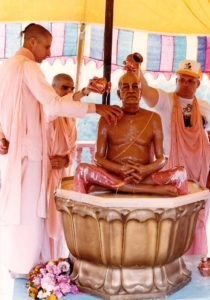
Prabhupada’s murti abishek at his Palace during Prabhupada Festival Radhanath & Brahmananda – early 1980s.
Prabhupada’s Palace was the first Samadhi to be completed for Srila Prabhupada in the world. To this day, it remains the only one of its kind in the West, a renowned Smriti Samadhi, or memorial shrine to ISKCON’s Founder-Acharya, and a monument to the love between Prabhupada and his disciples.
Today, as the crown jewel of New Vrindaban, Srila Prabhupada continues to reside in his Palace, embodied through both his murti form and his instructions. There, his sincere followers can still associate with him. And that connection cannot be underestimated.
As Srila Prabhupada himself reminded the devotees during his 1976 visit, “I am already living here… because you are all desiring it.”
